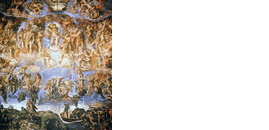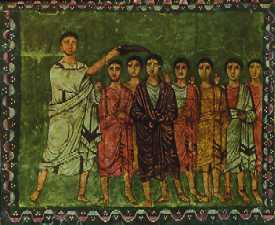
|
|
|
|
|
Class
Prep
|
|
|
|
- The
Genesis of Apocalyptic: Jewish Prophecy and Wisdom
-

- Today's readings were composed over a roughly 500 year-period
of Israelite history that began with a united monarchy based in
Jerusalem, devolved into two separate kingdoms of Israel and Judah,
and ended with the destruction of both of these kingdoms by successive
empires (the northern kingdom, Israel, was destroyed by the Assyrians
in 721 B.C.E., the southern kingdom by the Babylonians in 587/6
B.C.E.). Perhaps because it was short-lived, the original united monarchy provided a touchstone for the people's political hopes, and this became even truer after the Babylonian conquest, when Israel's monarchy was exterminated and its leaders taken into exile. While apocalyptic literature was not yet born, the legal, prophetic, wisdom and historical traditions that arose in this period were to become major ingredients in the later apocalyptic literature. In fact, apocalyptic literature is so dense with references to these past traditions that you will not understand it without some acquaintance with the prior traditions.
-
- The reading from Exodus is the original theophany or manifestation
of God in Jewish scripture, namely the giving of the ten words
on Mt. Sinai. The verse from Deuteronomy provides evidence
of that author's belief that a prophet "like Moses"
would come to guide the people sometime in the future. In
2 Samuel, we read of the oiling or anointing of David as the first
great king of the united monarchy (a selection depicted above;
David is the young man being chosen as king by the prophet Samuel). The remaining readings recount the narratives and oracles of some of Israel's greatest prophets, Elijah, Elisha, Isaiah and Malachi.
-
- Read these primary texts first, then read the Collins chapter on the origins of Jewish apocalyptic. As you read, consider the following issues and questions:
-
-
- What events accompany the divine theophany in Exodus?
- Compile a list of the "typical" things that prophets
do in these passages. Prophets you will encounter
are Moses, Samuel, Elijah, Elisha, Isaiah, and Malachi.
- Do any of these prophets stand out with some unique attributes?
- According to Collins, what characterizes the genre "apocalypse"? Be able to define "eschatology" and "apocalypticism."
- Based on your reading of pre-apocalyptic texts (our primary readings today) and Collins' description of the characteristic features of later apocalyptic texts, what elements would you say the later writers borrowed from earlier Jewish tradition to compose apocalypses? What techniques and literary elements did they take from other cultures?
-
-
- Assigned Readings
- Primary: Exodus 19–20, Deuteronomy 18:15; 2 Samuel
7:8-29; 1 Kings 17–19; 2 Kings 2; Isaiah 6–12; 24–27; 40–50;
65:17-25 ; Malachi 3:22-24 (all NRSV)
- Secondary: Collins 1-42
- Optional: The Vision of the Netherworld
and the Dynastic Prophecy (Babylon); the Bahman Yasht
and the Oracle of Hystaspes (Persia); Homer, Odyssey,
Book 11 (Greece; ERes)
-
-
- Further Reading
- Cohn,
Norman. Cosmos, Chaos, and the World to Come: The
Ancient Roots of Apocalyptic Faith. New Haven,
Connecticut: Yale University Press, 1993.
-
- Hellholm,
David. Apocalypticism in the Mediterranean World
and the Near East: Proceedings of the International Colloquium
on Apocalypticism, Uppsala, August 12-17, 1979. Tübingen:
J. C. B. Mohr (Paul Siebeck), 1983.
-
 Seltzer,
Robert M. Jewish People, Jewish Thought: The Jewish
Experience in History. New York: Macmillan, 1980. Seltzer,
Robert M. Jewish People, Jewish Thought: The Jewish
Experience in History. New York: Macmillan, 1980.
-
- See also the section of the Course Bibliography on Ancient Pagan Apocalypticism.
-
-
- Links
-
-
-
- Sources
- Photograph: Plate LXVI in A. R. Bellinger, F. E. Brown, A. Perkins and C. B. Welles, eds., The Excavations at Dura-Europos Conducted by Yale University and the French Academy of Inscriptions and Letters, Final Report VIII, Part 1 (New Haven, Connecticut: Yale University Press, 1956).
|
|
|
|
|
